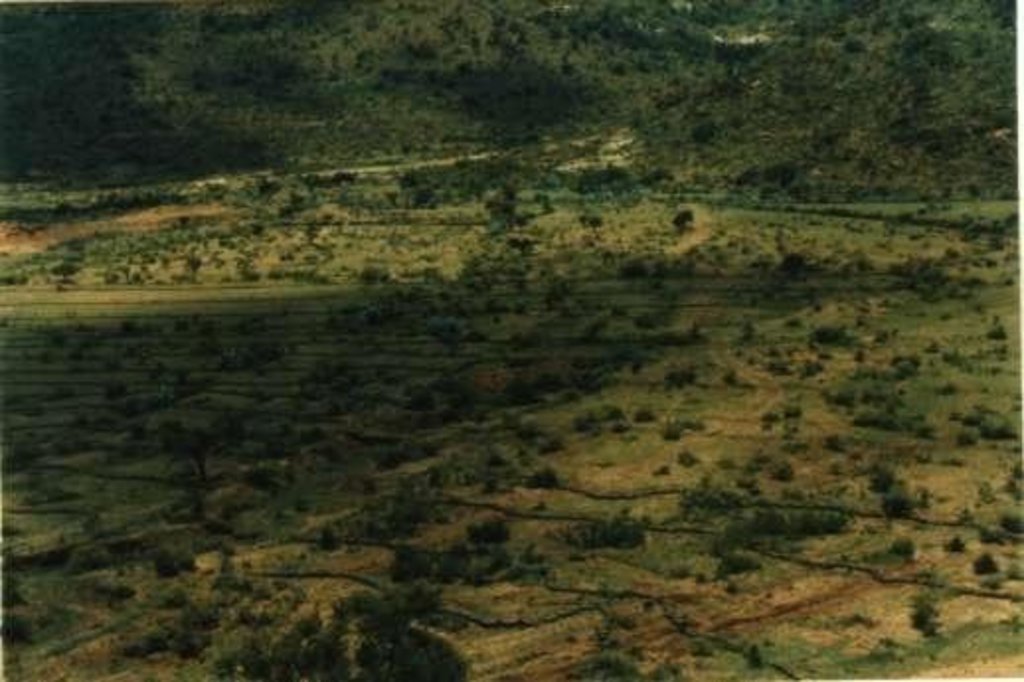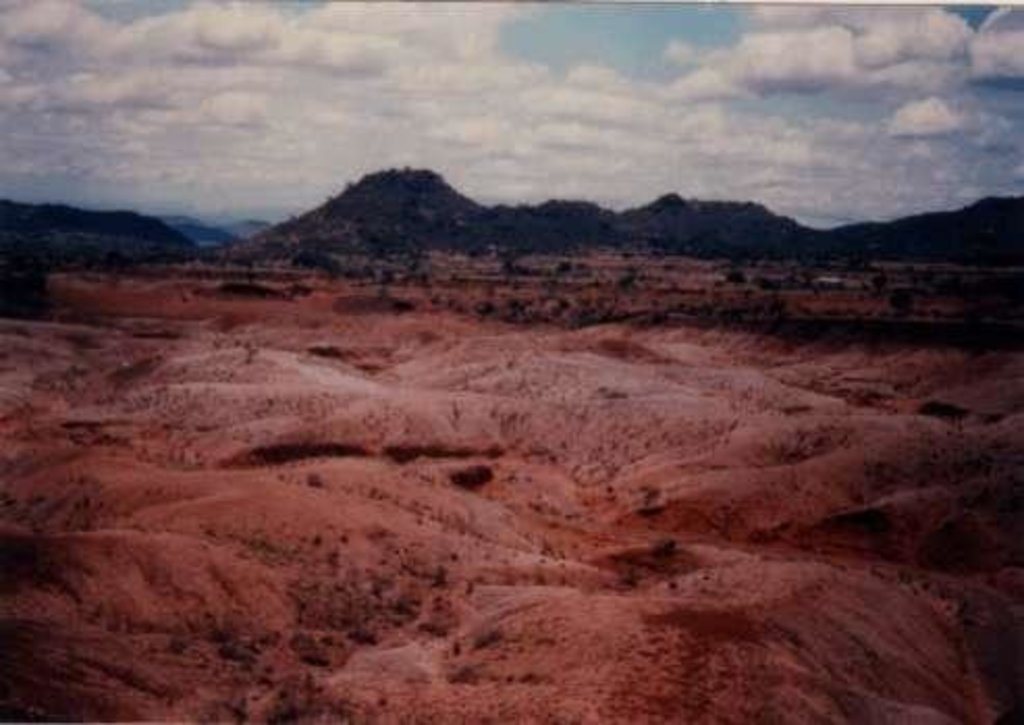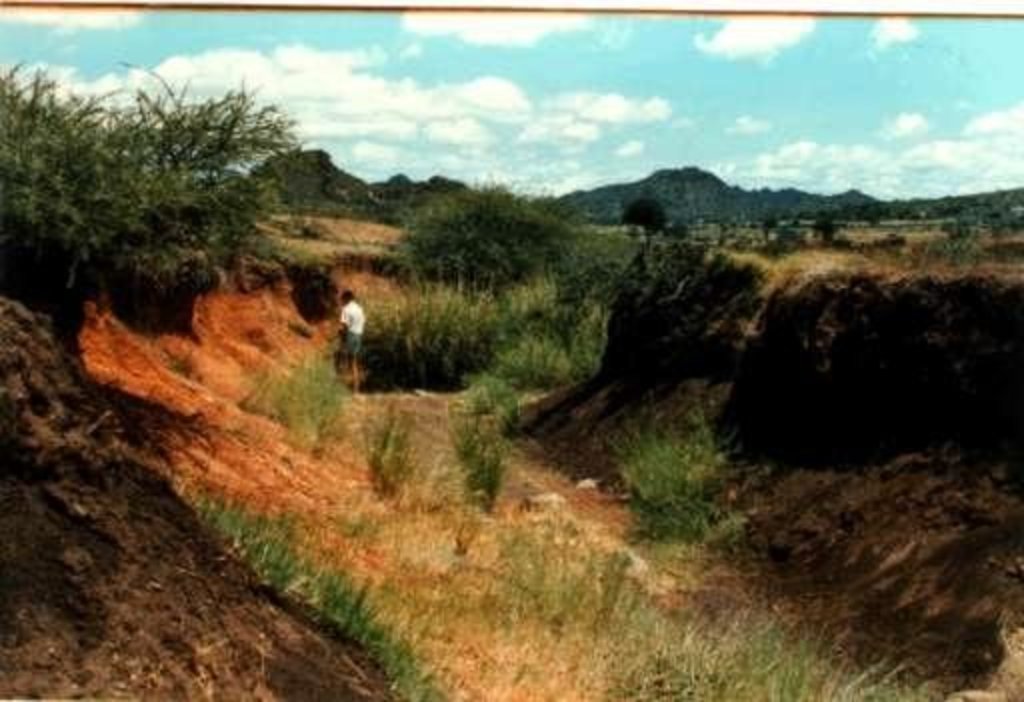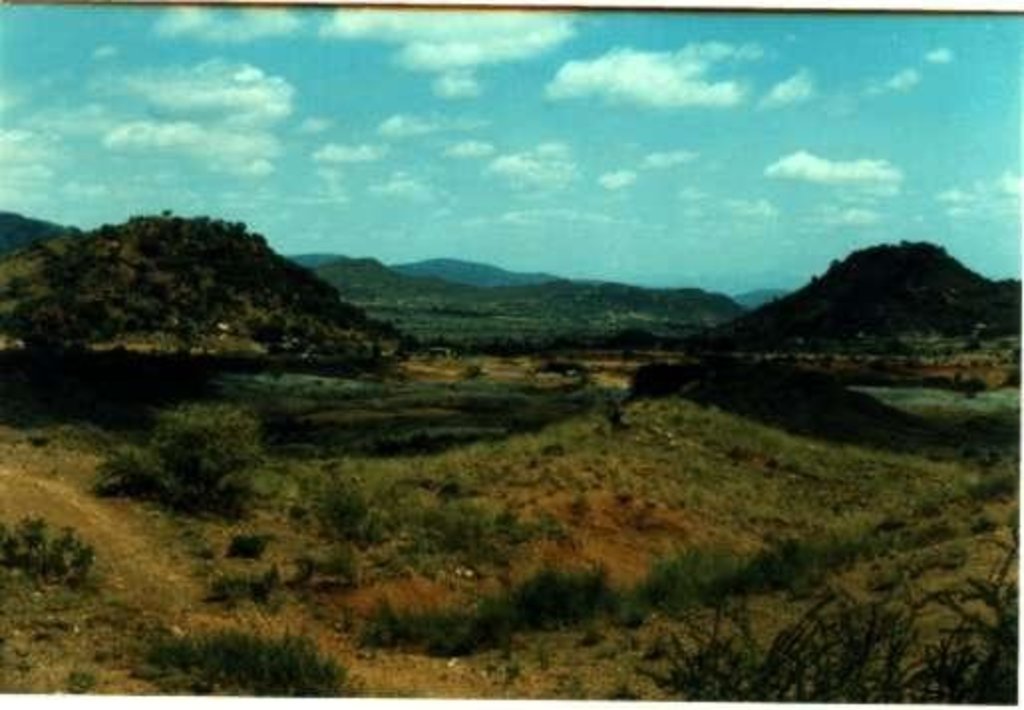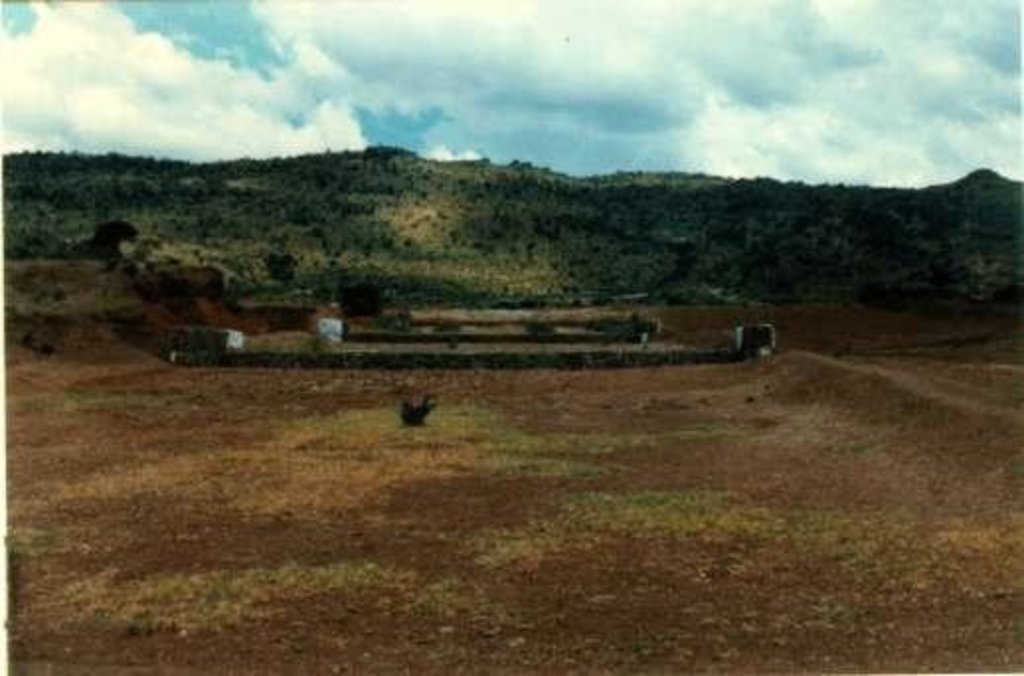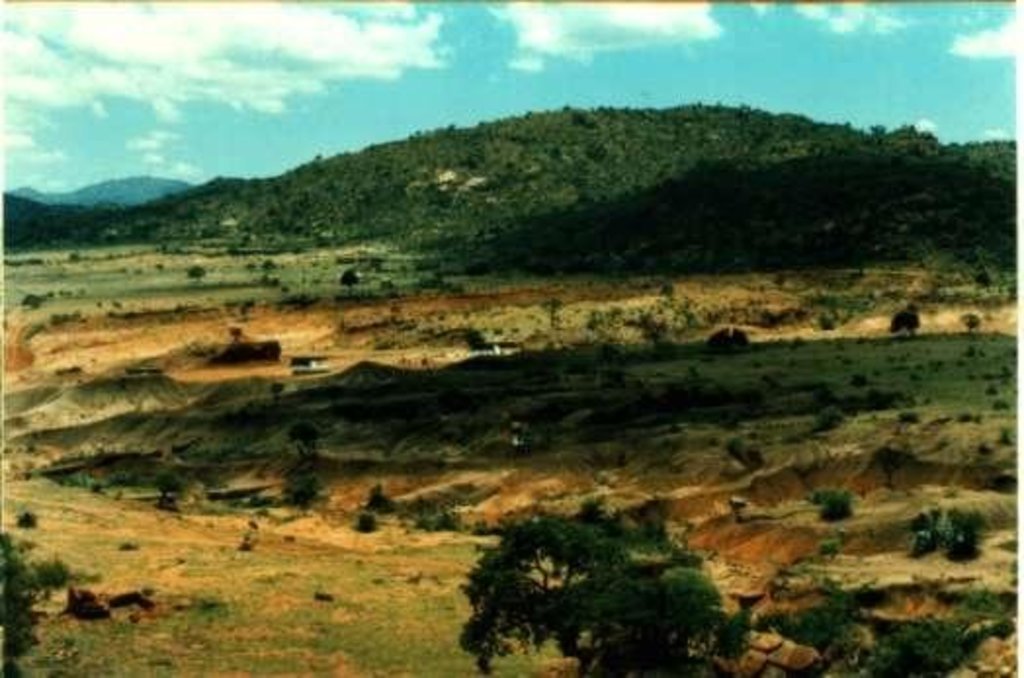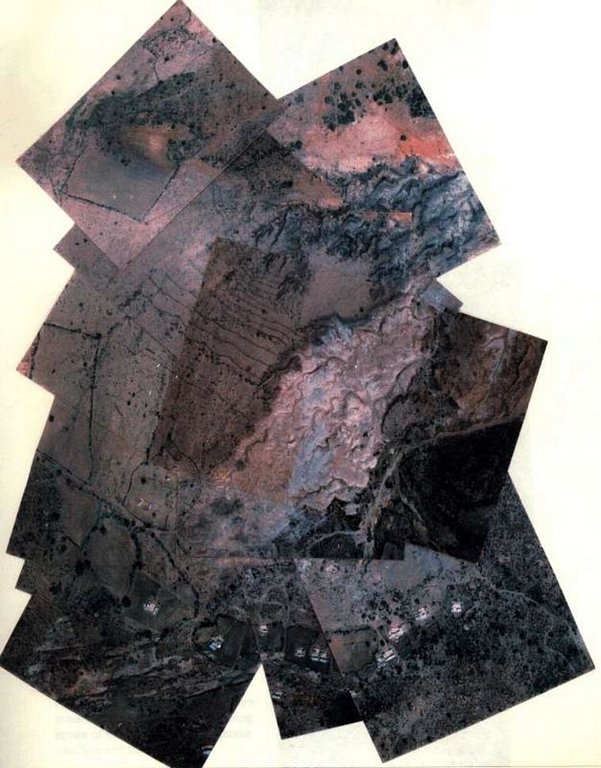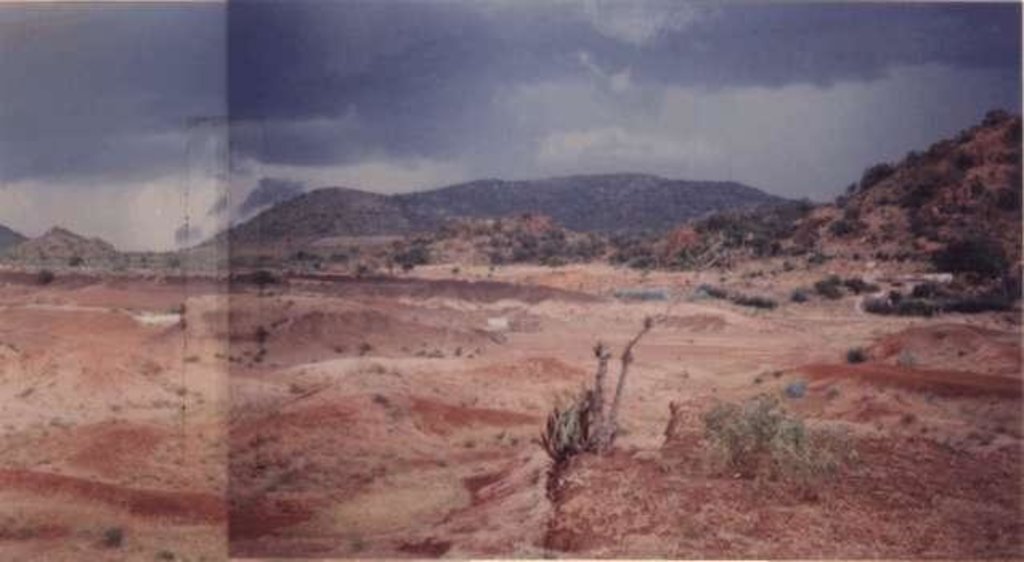Old Motor Tyre Contours [ប្រទេសអាហ្រ្វិកខាងត្បូង]
- ការបង្កើត៖
- បច្ចុប្បន្នភាព
- អ្នកចងក្រង៖ Andrei Rozanov
- អ្នកកែសម្រួល៖ –
- អ្នកត្រួតពិនិត្យ David Streiff
technologies_1368 - ប្រទេសអាហ្រ្វិកខាងត្បូង
ពិនិត្យមើលគ្រប់ផ្នែក
ពង្រីកមើលទាំងអស់ បង្រួមទាំងអស់1. ព័ត៌មានទូទៅ
1.2 ព័ត៌មានលម្អិតពីបុគ្គលសំខាន់ៗ និងស្ថាប័នដែលចូលរួមក្នុងការវាយតម្លៃ និងចងក្រងឯកសារនៃបច្ចេកទេស
អ្នកជំនាញឯកទេស SLM:
Cujisi K.
UNIN
Van der Walt Isac
Forestry technician:
Voster T.
Department Water Affairs & Forestry, Groblersdal, South Africa
ប្រទេសអាហ្រ្វិកខាងត្បូង
ឈ្មោះអង្គភាពមួយ (ច្រើន) ដែលបានចងក្រងឯកសារ/ វាយតម្លៃបច្ចេកទេស (បើទាក់ទង)
University of Stellenbosch (University of Stellenbosch) - ប្រទេសអាហ្រ្វិកខាងត្បូងឈ្មោះអង្គភាពមួយ (ច្រើន) ដែលបានចងក្រងឯកសារ/ វាយតម្លៃបច្ចេកទេស (បើទាក់ទង)
United Nations Institute for Namibia (UNIN) - ប្រទេសណាមីប៊ីឈ្មោះអង្គភាពមួយ (ច្រើន) ដែលបានចងក្រងឯកសារ/ វាយតម្លៃបច្ចេកទេស (បើទាក់ទង)
Department of Water Affairs and Forestry (DWAF) - ប្រទេសអាហ្រ្វិកខាងត្បូង1.3 លក្ខខណ្ឌទាក់ទងទៅនឹងការប្រើប្រាស់ទិន្នន័យដែលបានចងក្រងតាមរយៈ វ៉ូខេត
តើពេលណាដែលទិន្នន័យបានចងក្រង (នៅទីវាល)?
06/12/1995
អ្នកចងក្រង និង(បុគ្គលសំខាន់ៗ)យល់ព្រមទទួលយកនូវលក្ខខណ្ឌនានាទាក់ទងទៅនឹងការប្រើប្រាស់ទិន្នន័យដែលបានចងក្រងតាមរយៈវ៉ូខេត:
បាទ/ចា៎
2. ការពណ៌នាពីបច្ចេកទេស SLM
2.1 ការពណ៌នាដោយសង្ខេបពីបច្ចេកទេស
និយមន័យបច្ចេកទេស:
Old motor tyres and/or vegetation along contours.
2.2 ការពណ៌នាលម្អិតពីបច្ចេកទេស
ការពណ៌នា:
The site of Geen Einde is typical of many areas in Lebowa: a large gully approximately 200 m wide and 10 m deep in places with semi-eroded pedestals remaining. Flood waters from the mountain meanders causes further gouging of the sides of the pedestals. Tributary gullies have formed in the highly erodible soil (high clay content) adjacent to the main gully. Signs of old contour bunds indicate that the land was cultivated in the past.
1. An earth silt dam was mechanically constructed across the main erosion gully.
2. Several gabion structures were constructed in the minor gullies.
3. Vetiver grass was planted in the silt to act as nursery material for future planting.
4. Old motor tyres were laid on a level contour above the minor gullies to harvest water.
5. Several species of indigenous trees were planted in the gullies and along the rows of tyres.
6. Two Agave species, local aloes and vetiver grass were planted along level contours.
7. Agave was planted along the edges of the gullies.
8. Shallow gullies were stabilised with old tyres and Agave.
9. Couch grass (Cynodon dactylon) was planted at a few places in the gullies and along the rows of tyres.
The main reason for these actions was to reduce the water velocity.
2.3 រូបភាពនៃបច្ចេកទេស
2.5 ប្រទេស/តំបន់/ទីតាំងកន្លែង ដែលបច្ចេកទេសត្រូវបានអនុវត្ត និងបានគ្រប់ដណ្តប់ដោយការវាយតម្លៃនេះ
ប្រទេស:
ប្រទេសអាហ្រ្វិកខាងត្បូង
តំបន់/រដ្ឋ/ខេត្ត:
Limpopo Province
បញ្ជាក់បន្ថែមពីលក្ខណៈនៃទីតាំង:
Sekhukhunenland
2.6 កាលបរិច្ឆេទនៃការអនុវត្ត
ប្រសិនបើមិនច្បាស់ឆ្នាំ សូមបញ្ជាក់កាលបរិច្ឆេទដែលប្រហាក់ប្រហែល:
- តិចជាង 10ឆ្នាំមុន (ថ្មី)
2.7 ការណែនាំពីបច្ចេកទេស
សូមបញ្ជាក់តើបច្ចេកទេសត្រូវបានណែនាំឱ្យអនុវត្តដោយរបៀបណា:
- ពេលកំពុងពិសោធន៍
មតិយោបល់ (ប្រភេទនៃគម្រោង ។ល។):
Having read about the success achieved by placing stone barriers on a level contour in other parts of Africa, but also being aware that the process is slow and laborious and dependent on the availability of stones, the thought come to mind to use old motor tyres instead.
First in the area (my original idea).
3. ចំណាត់ថ្នាក់នៃបច្ចេកទេស SLM
3.1 គោលបំណងចម្បង (១ ឬច្រើន) នៃបច្ចេកទេសនេះ
- កាត់បន្ថយ, បង្ការ, ស្តារឡើងវិញនូវការធ្លាក់ចុះគុណភាពដី
3.2 ប្រភេទដីប្រើប្រាស់មួយប្រភេទ (ច្រើនប្រភេទ) ដែលបានអនុវត្តបច្ចេកទេស

ដីសម្រាប់ចិញ្ចឹមសត្វ
ដីវាលស្មៅធំៗ:
- ពាក់កណ្តាលពនេចរ

ដីព្រៃ/ដីដាំដើមឈើ
ព្រៃ (ពាក់កណ្តាល) ធម្មជាតិ/ ដីព្រៃ:
- កាប់តែមួយចំនួន
- កាប់ទាំងអស់
ផលិតផល និងសេវាកម្ម:
- អុស
- ផលិតផលព្រៃផ្សេងៗ
- វាលស្មៅ
មតិយោបល់:
Major land use problems (compiler’s opinion): Severe environmental degradation (less graze cover over grazing, considerable silt in the river going into Olifants river a main resource for Kruger National Park, below gabion construction were silted up in one year (some even in one rainstorm).
Major land use problems (land users’ perception): Poverty, land tenure free range for the whole community
Semi-nomadism / pastoralism: Yes
Grazingland comments: The area was not fenced off at all.
Selective felling of (semi-) natural forests: Yes
Clear felling of (semi-)natural forests: one of the reason for erosion
Problems / comments regarding forest use: So far only indigenous trees have been planted, but there are many exotic species that can also be investigated. For example, the carob can be tried as a commercial crop, the mulberry as a fodder and fruit crop.
Forest products and services: fuelwood, grazing / browsing, other forest products / uses (honey, medical, etc.)
Type of grazing system comments: The area was not fenced off at all.
Constraints of settlement / urban: scattered
3.3 ព័ត៌មានបន្ថែមអំពីអ្នកប្រើប្រាស់ដី
ចំនួនសារដែលដាំដំណាំក្នុងមួយឆ្នាំ:
- 1
សូមបញ្ជាក់:
Longest growing period in days: 210
3.4 ក្រុម SLM ដែលបច្ចេកទេសស្ថិតនៅក្នុង
- វិធានការអនុវត្តកាត់ទទឹងទីជម្រាល
- ការស្តុកទុកទឹក
3.5 ការសាយភាយនៃបច្ចេកទេស
បញ្ជាក់ពីការសាយភាយនៃបច្ចេកទេស:
- ត្រូវបានផ្សព្វផ្សាយត្រឹមតំបន់មួយ
ប្រសិនបើបច្ចេកទេសត្រូវបានសាយភាយពាសពេញតំបន់ណាមួយ សូមកំណត់ទំហំផ្ទៃដីអនុវត្តន៍:
- 0.1-1 គម2
មតិយោបល់:
Total area covered by the SLM Technology is 0.1 km2.
Green Einde is a tribal area in Sekhukhuneland, which is one of the most severely degraded areas in the Northern Province. It is mainly mountainous, with numerous fertile valleys draining into the Oilfants river, one of the main rivers leading into the Kruger National Park.
Sekhukhuneland is severely degraded. A soil degradation survey done of the former Homeland, Lebowa, by satellite remote sensing in 1993, revealed that in Sekhukhuneland alone approximately 16800ha has become an erosion gully, or bare soil, with little or no vegetation.
This means that 3360 potential farmers have effectively been deprived of 5ha each.
3.6 វិធានការ SLM ដែលបញ្ចូលនូវបច្ចេកទេស

វិធានការរុក្ខជាតិ
- V2: ស្មៅនិងរុក្ខជាតិៗដែលដុះមានអាយុមិនលើសពី 2ឆ្នាំ

វិធានការរចនាស័ម្ពន្ធ
- S5: ទំនប់ ថ្លុក ស្រះ
មតិយោបល់:
Main measures: structural measures
Secondary measures: vegetative measures
3.7 កំណត់ប្រភេទនៃការធ្លាក់ចុះគុណភាពដីសំខាន់ៗដែលបច្ចេកទេសនេះបានដោះស្រាយ

ការហូរច្រោះដីដោយសារទឹក
- Wt: ការបាត់ដីស្រទាប់លើដោយការហូរច្រោះ
- Wg: ការកកើតឡើងនូវកំទេចកំទីដីស្រទាប់ក្រោម
3.8 ការពារ កាត់បន្ថយ ឬស្តារឡើងវិញនៃការធ្លាក់ចុះគុណភាពដី
បញ្ជាក់ពីគោលដៅរបស់បច្ចេកទេស ដែលផ្តោតទៅការធ្លាក់ចុះគុណភាពដី:
- ការការពារការធ្លាក់ចុះគុណភាពដី
- ការកាត់បន្ថយការធ្លាក់ចុះគុណភាពដី
មតិយោបល់:
Secondary goals: mitigation / reduction of land degradation
4. បច្ចេកទេសជាក់លាក់ សកម្មភាពអនុវត្ត ធាតុចូល និងថ្លៃដើម
4.2 លក្ខណៈពិសេសនៃបច្ចេកទេស/ ពណ៌នាពីគំនូរបច្ចេកទេស
Technical knowledge required for field staff / advisors: moderate
Technical knowledge required for land users: low
Main technical functions: improvement of ground cover, increase in organic matter, water harvesting / increase water supply
Secondary technical functions: increase of infiltration, increase / maintain water stored in soil
Vegetative measure: contour
Vegetative material: O : other
Vertical interval within rows / strips / blocks (m): 10cm
Vegetative measure: contour
Vegetative material: O : other
Vertical interval within rows / strips / blocks (m): 1m
Vegetative measure: contour
Vegetative material: O : other
Vertical interval within rows / strips / blocks (m): 20cm
Vegetative measure: contour
Vegetative material: O : other
Trees/ shrubs species: Agave sisalana & Agave mexicane
Grass species: Vetiver
Other species: Acacia tortilis, Portulacaria afra
Slope (which determines the spacing indicated above): 1.00%
If the original slope has changed as a result of the Technology, the slope today is (see figure below): 1.00%
Gradient along the rows / strips: 1.00%
Retention/infiltration ditch/pit, sediment/sand trap
Spacing between structures (m): 10-30
Depth of ditches/pits/dams (m): 30cm
Width of ditches/pits/dams (m): 50cm
Length of ditches/pits/dams (m): 200m
Construction material (other): old motor tyres
Lateral gradient along the structure: 1%
For water harvesting: the ratio between the area where the harvested water is applied and the total area from which water is collected is: 1:30
Vegetation is used for stabilisation of structures.
Control / change of species composition
4.3 ព័ត៌មានទូទៅដែលពាក់ព័ន្ធនឹងការគណនាធាតុចូល និងថ្លៃដើម
ផ្សេងៗ/ រូបិយប័ណ្ណជាតិ (បញ្ជាក់):
rand
កំណត់អត្រាប្តូរប្រាក់ពីដុល្លាទៅរូបិយប័ណ្ណតំបន់ (បើទាក់ទង)៖ 1 ដុល្លារ =:
6,0
កំណត់ថ្លៃឈ្នួលជាមធ្យមនៃការជួលកម្លាំងពលកម្មក្នុងមួយថ្ងៃ:
4.00
4.4 សកម្មភាពបង្កើត
| សកម្មភាព | ប្រភេទវិធានការ | ពេលវេលា | |
|---|---|---|---|
| 1. | transplanting Vetiver and trees | សារពើរុក្ខជាតិ | before rains - ongoing |
| 2. | planting Agave | សារពើរុក្ខជាតិ | all year round |
| 3. | 1. placing motor tyres and earth | រចនាសម្ព័ន្ធ | ok-ap (rainseason) |
4.5 ថ្លៃដើម និងធាតុចូលដែលត្រូវការសម្រាប់ការបង្កើតបច្ចេកទេស
| បញ្ជាក់ពីធាតុចូល | ឯកតា | បរិមាណ | ថ្លៃដើមក្នុងមួយឯកតា | ថ្លៃធាតុចូលសរុប | % នៃថ្លៃដើមដែលចំណាយដោយអ្នកប្រើប្រាស់ដី | |
|---|---|---|---|---|---|---|
| កម្លាំងពលកម្ម | Labour | ha | 1,0 | 83,35 | 83,35 | |
| សម្ភារៈ | Machine use | ha | 1,0 | 11,0 | 11,0 | |
| សម្ភារៈដាំដុះ | Trees | ha | 1,0 | 888,0 | 888,0 | |
| ផ្សេងៗ | tyre transport | ha | 1,0 | 138,0 | 138,0 | 100,0 |
| ថ្លៃដើមសរុបក្នុងការបង្កើតបច្ចេកទេស | 1120,35 | |||||
មតិយោបល់:
Duration of establishment phase: 36 month(s)
4.6 សកម្មភាពថែទាំ
| សកម្មភាព | ប្រភេទវិធានការ | ពេលវេលា/ ភាពញឹកញាប់ | |
|---|---|---|---|
| 1. | pruning / trimming | សារពើរុក្ខជាតិ | need /periodically |
4.8 កត្តាសំខាន់បំផុតដែលមានឥទ្ធិពលដល់ការចំណាយ
ពណ៌នាពីកត្តាប៉ះពាល់ចម្បងៗទៅលើថ្លៃដើម:
The main expense is transporting the tyres which depends on the distance travelled.
It is obvious that any increase in the cost of labour will have a market impact on final costs.
5. លក្ខណៈបរិស្ថានធម្មជាតិ និងមនុស្ស
5.1 អាកាសធាតុ
បរិមាណទឹកភ្លៀងប្រចាំឆ្នាំ
- < 250 មម
- 251-500 មម
- 501-750 មម
- 751-1,000 មម
- 1,001-1,500 មម
- 1,501-2,000 មម
- 2,001-3,000 មម
- 3,001-4,000 មម
- > 4,000 មម
តំបន់កសិអាកាសធាតុ
- មានភ្លៀងតិចតួច
thunderstorm
5.2 សណ្ឋានដី
ជម្រាលជាមធ្យម:
- រាបស្មើ (0-2%)
- ជម្រាលតិចតួច (3-5%)
- មធ្យម (6-10%)
- ជម្រាលខ្ពស់បន្តិច (11-15%)
- ទីទួល (16-30%)
- ទីទួលចោត (31-60%)
- ទីទួលចោតខ្លាំង (>60%)
ទម្រង់ដី:
- ខ្ពង់រាប
- កំពូលភ្នំ
- ជម្រាលភ្នំ
- ជម្រាលទួល
- ជម្រាលជើងភ្នំ
- បាតជ្រលងភ្នំ
តំបន់តាមរយៈកម្ពស់ :
- 0-100 ម
- 101-500 ម
- 501-1,000 ម
- 1,001-1,500 ម
- 1,501-2,000 ម
- 2,001-2,500 ម
- 2,501-3,000 ម
- 3,001-4,000 ម
- > 4,000 ម
5.3 ដី
ជម្រៅដីជាមធ្យម:
- រាក់ខ្លាំង (0-20 សម)
- រាក់ (21-50 សម)
- មធ្យម (51-80 សម)
- ជ្រៅ (81-120 សម)
- ជ្រៅខ្លាំង (> 120 សម)
វាយនភាពដី (ស្រទាប់លើ):
- ម៉ត់/ ធ្ងន់ (ឥដ្ឋ)
សារធាតុសរីរាង្គនៅស្រទាប់ដីខាងលើ:
- ទាប (<1%)
បើអាចសូមភ្ជាប់ការពណ៌នាពីដីឱ្យបានច្បាស់ ឬព័ត៌មានដែលអាចទទួលបាន ឧ. ប្រភេទដី, pH ដី/ ជាតិអាស៊ីត, សមត្ថភាពផ្លាស់ប្តូរកាចុង, វត្តមាននីត្រូសែន, ភាពប្រៃ ។ល។:
Soil depth on average: Also shallow
Soil fertility is low - very low
Soil drainage / infiltration is poor
Soil water storage capacity is low - medium
5.6 លក្ខណៈនៃអ្នកប្រើប្រាស់ដីដែលអនុវត្តបច្ចេកទេស
ទីផ្សារនៃប្រព័ន្ធផលិតកម្ម:
- សម្រាប់ហូបក្នុងគ្រួសារ (ផ្គត់ផ្គង់ខ្លួនឯង)
ចំណូលក្រៅកសិកម្ម:
- តិចជាង 10% នៃចំណូល
កម្រិតជីវភាព:
- មិនល្អខ្លាំង
- មិនល្អ
សូមបញ្ជាក់ពីលក្ខណៈពាក់ព័ន្ធផ្សេងទៀតអំពីអ្នកប្រើប្រាស់ដី:
Population density: 10-50 persons/km2
Annual population growth: 0.5% - 1%
(other income (e.g. bottle store)).
Off-farm income specification: Pension very important
Market orientation of production system: Probable, no sure if on market
5.7 ទំហំផ្ទៃដីជាមធ្យមនៃដីផ្ទាល់ខ្លួន ឬជួលគេដែលបានអនុវត្តបច្ចេកទេស
- < 0.5 ហិកតា
- 0.5-1 ហិកតា
- 1-2 ហិកតា
- 2-5 ហិកតា
- 5-15 ហិកតា
- 15-50 ហិកតា
- 50-100 ហិកតា
- 100-500 ហិកតា
- 500-1,000 ហិកតា
- 1,000-10,000 ហិកតា
- > 10,000 ហិកតា
5.8 ភាពជាម្ចាស់ដី កម្មសិទ្ធប្រើប្រាស់ដី និងកម្មសិទ្ធប្រើប្រាស់ទឹក
ភាពជាម្ចាស់ដី:
- ភូមិ
កម្មសិទ្ធិប្រើប្រាស់ដី:
- អាស្រ័យផលសេរី (មិនមានការកំណត់)
6. ផលប៉ះពាល់ និងការសន្និដ្ឋាន
6.1 ផលប៉ះពាល់ក្នុងបរិវេណអនុវត្តបច្ចេកទេសដែលកើតមាន
ផលប៉ះពាល់លើសេដ្ឋកិច្ចសង្គម
ផលិតផល
ផលិតកម្មចំណីសត្វ
គុណភាពចំណីសត្វ
ផលិតកម្មឈើ
ផ្ទៃដីផលិតកម្ម
មតិយោបល់/ ការបញ្ជាក់:
stabilised gullies can be used for production, in Lesotho such gullies are allocated
ចំណូល និងថ្លៃដើម
ចំណូលក្នុងកសិដ្ឋាន
ភាពខុសគ្នាផ្នែកសេដ្ឋកិច្ច
បន្ទុកការងារ
ផលប៉ះពាល់ទៅលើសេដ្ឋកិច្ចសង្គមផ្សេងៗ
initial cost
មតិយោបល់/ ការបញ្ជាក់:
relatively cheap method using old tyres and ripper, the main expense is transporting the tyres
ផលប៉ះពាល់ទៅលើវប្បធម៌សង្គម
ស្ថាប័នសហគមន៍
ចំណេះដឹង SLM / ការធ្លាក់ចុះគុណភាពដី
ការកាត់បន្ថយជម្លោះ
rehabilitation can take place without denying people/animal
ផលប៉ះពាល់ទៅលើអេកូឡូស៊ី
វដ្តទឹក/លំហូរ
ការប្រមូលស្តុកទុកទឹក
លំហូរទឹកលើផ្ទៃដី
គុណភាពមុន SLM:
50
គុណភាពក្រោយ SLM:
10
ប្រព័ន្ធបង្ហូរទឹក
ដី
សំណើមដី
គម្របដី
ការបាត់បង់ដី
គុណភាពមុន SLM:
8
គុណភាពក្រោយ SLM:
2
ផលប៉ះពាល់ទៅលើអេកូឡូស៊ីផ្សេងៗ
soil fertility
biodiversity
ground level
មតិយោបល់/ ការបញ្ជាក់:
Not sure if reason is technology
6.2 ផលប៉ះពាល់ក្រៅបរិវេណអនុវត្តបច្ចេកទេសដែលកើតមាន
ទឹកជំនន់ខ្សែទឹកខាងក្រោម
6.4 ការវិភាគថ្លៃដើម និងអត្ថប្រយោជន៍
តើផលចំណេញ និងថ្លៃដើមត្រូវបានប្រៀបធៀបគ្នាយ៉ាងដូចម្តេច (ទស្សនៈរបស់អ្នកប្រើប្រាស់ដី)?
រយៈពេលខ្លី:
វិជ្ជមាន
រយៈពេលវែង:
វិជ្ជមាន
តើផលចំណេញ និងការថែទាំ/ ជួសជុលត្រូវបានប្រៀបធៀបគ្នាយ៉ាងដូចម្តេច (ទស្សនៈរបស់អ្នកប្រើប្រាស់ដី)?
រយៈពេលខ្លី:
ប៉ះពាល់តិចតួចបំផុត
រយៈពេលវែង:
ប៉ះពាល់តិចតួចបំផុត
6.5 ការទទួលយកបច្ចេកទេស
មតិយោបល់:
There is a moderate trend towards spontaneous adoption of the Technology
Comments on adoption trend: Interest is increasing.
6.7 ភាពខ្លាំង/ គុណសម្បត្តិ/ ឱកាសនៃបច្ចេកទេស
| ភាពខ្លាំង/ គុណសម្បត្តិ/ ឱកាសនៅកន្លែងរបស់អ្នកប្រើប្រាស់ដី |
|---|
| Easy to implement and benefits from food, fuel and fodder. |
| Improved graze cover. |
| Improved trees cover. |
| Improved trees cover. |
| ភាពខ្លាំង/ គុណសម្បត្តិ/ ឱកាស ទស្សនៈរបស់បុគ្គលសំខាន់ៗ |
|---|
|
Capture water and sediment for growth of plants. How can they be sustained / enhanced? More of the same technology. |
|
Improved graze cover. How can they be sustained / enhanced? More of the same technology. |
| Improved trees cover. |
| Improved water management. |
| Improved biodiversity. |
6.8 ភាពខ្សោយ/ គុណវិបត្តិ/ ហានិភ័យនៃបច្ចេកទេស និងវិធីសាស្ត្រដោះស្រាយ
| ភាពខ្សោយ/ គុណវិបត្តិ/ ហានិភ័យ ទស្សនៈរបស់អ្នកប្រើប្រាស់ដី | តើបច្ចេកទេសទាំងនោះបានដោះស្រាយបញ្ហាដូចម្តេច? |
|---|---|
| Paths may be blocked. | Put more soil on the tyres |
| Transport cost for tyres. |
| ភាពខ្សោយ/ គុណវិបត្តិ/ ហានិភ័យ ទស្សនៈរបស់អ្នកចងក្រងឬបុគ្គលសំខាន់ៗ | តើបច្ចេកទេសទាំងនោះបានដោះស្រាយបញ្ហាដូចម្តេច? |
|---|---|
| Transport costs of tyres. | Selesert sponsorship. |
| Tyres all over the area may be unsightly. | Cover the tyres with soil and vegetation. |
7. ឯកសារយោង និងវេបសាយ
7.2 ឯកសារយោងដែលបានចេញផ្សាយ
ចំណងជើង អ្នកនិពន្ធ ឆ្នាំ ISBN:
Progress Report. Feb-94.
មានប្រភពមកពីណា? ថ្លៃដើមប៉ុន្មាន?
C.W. Spies
ការតភ្ជាប់ និងម៉ូឌុល
ពង្រីកមើលទាំងអស់ បង្រួមទាំងអស់ការតភ្ជាប់
គ្មានការតភ្ជាប់
ម៉ូឌុល
គ្មានម៉ូឌុល



